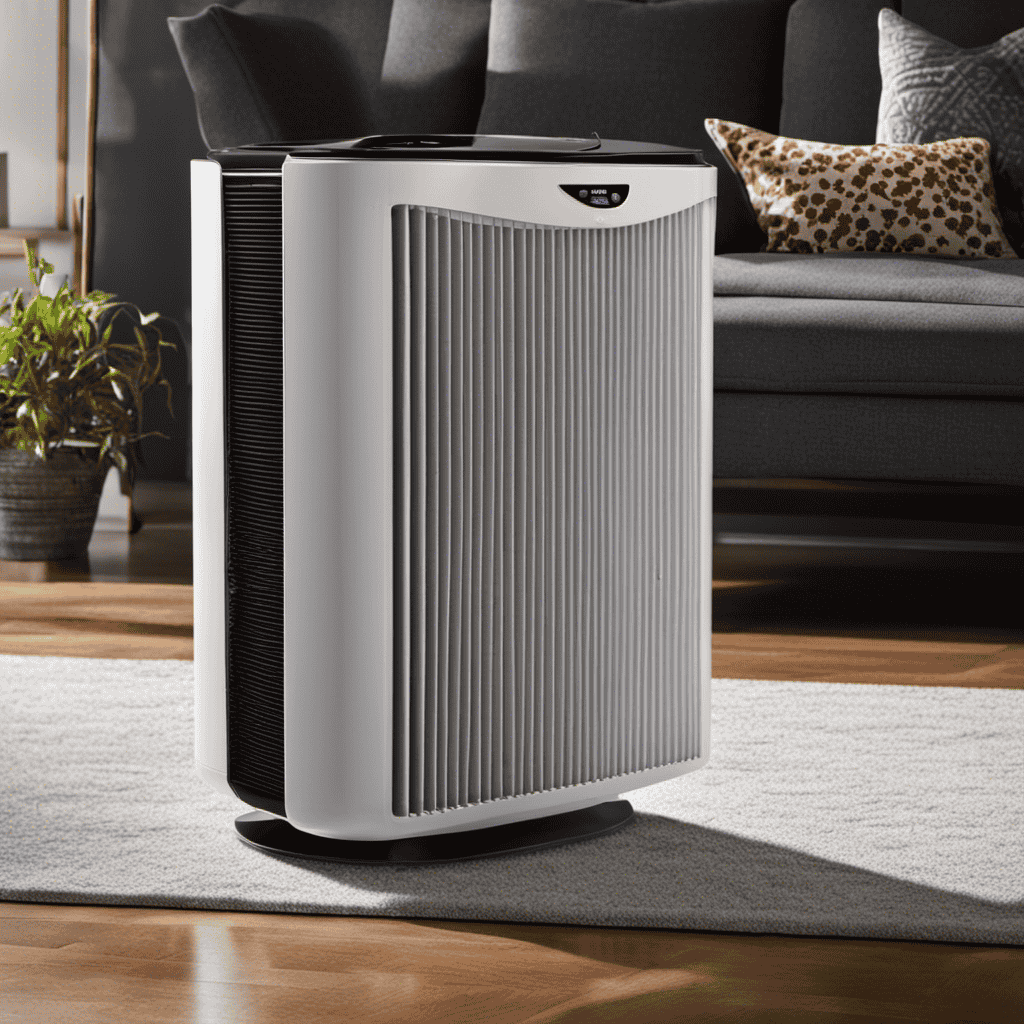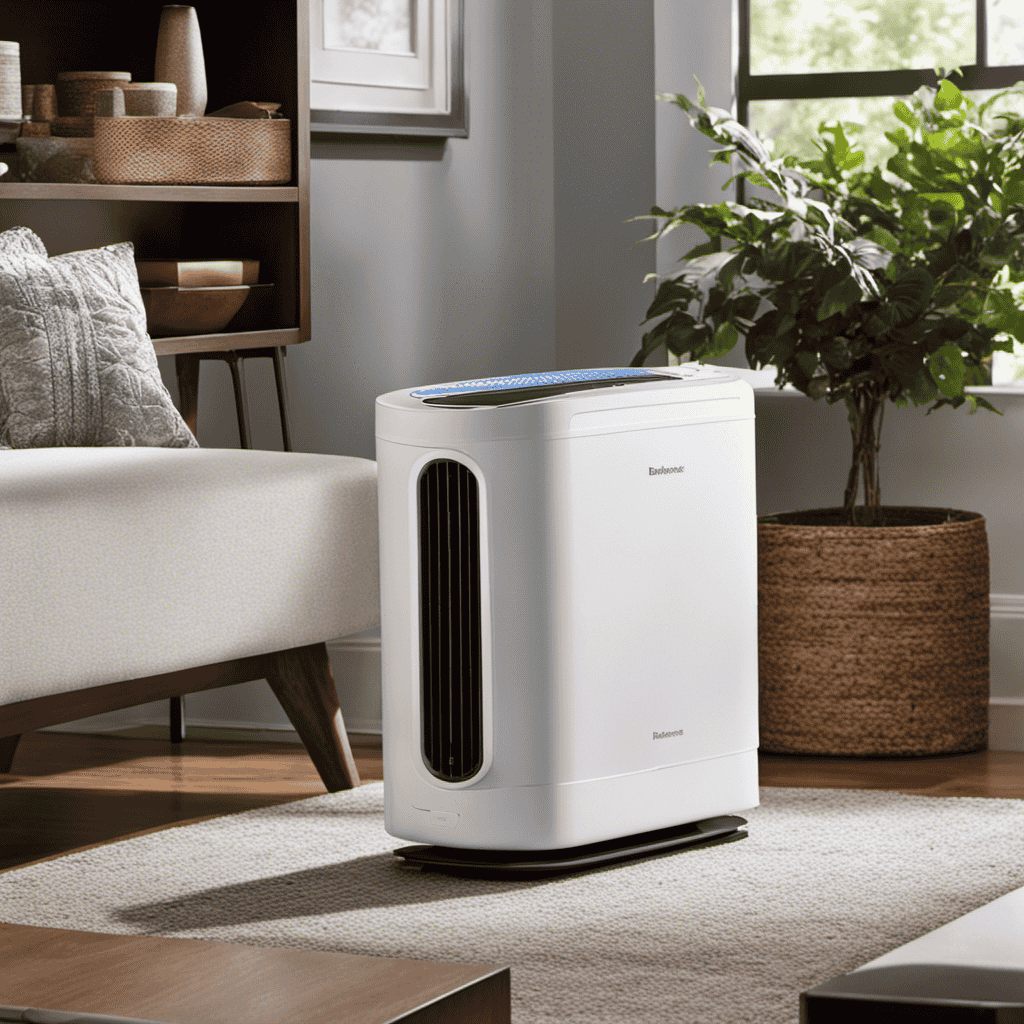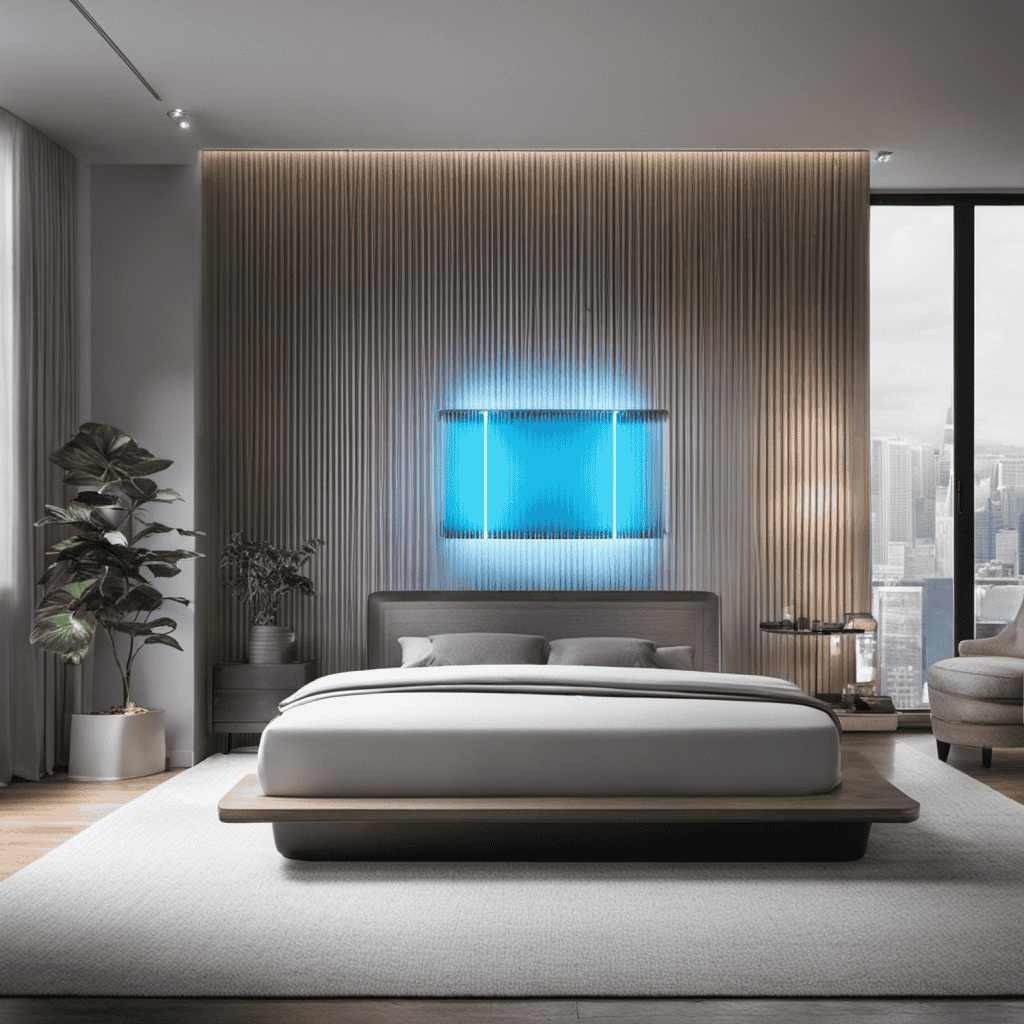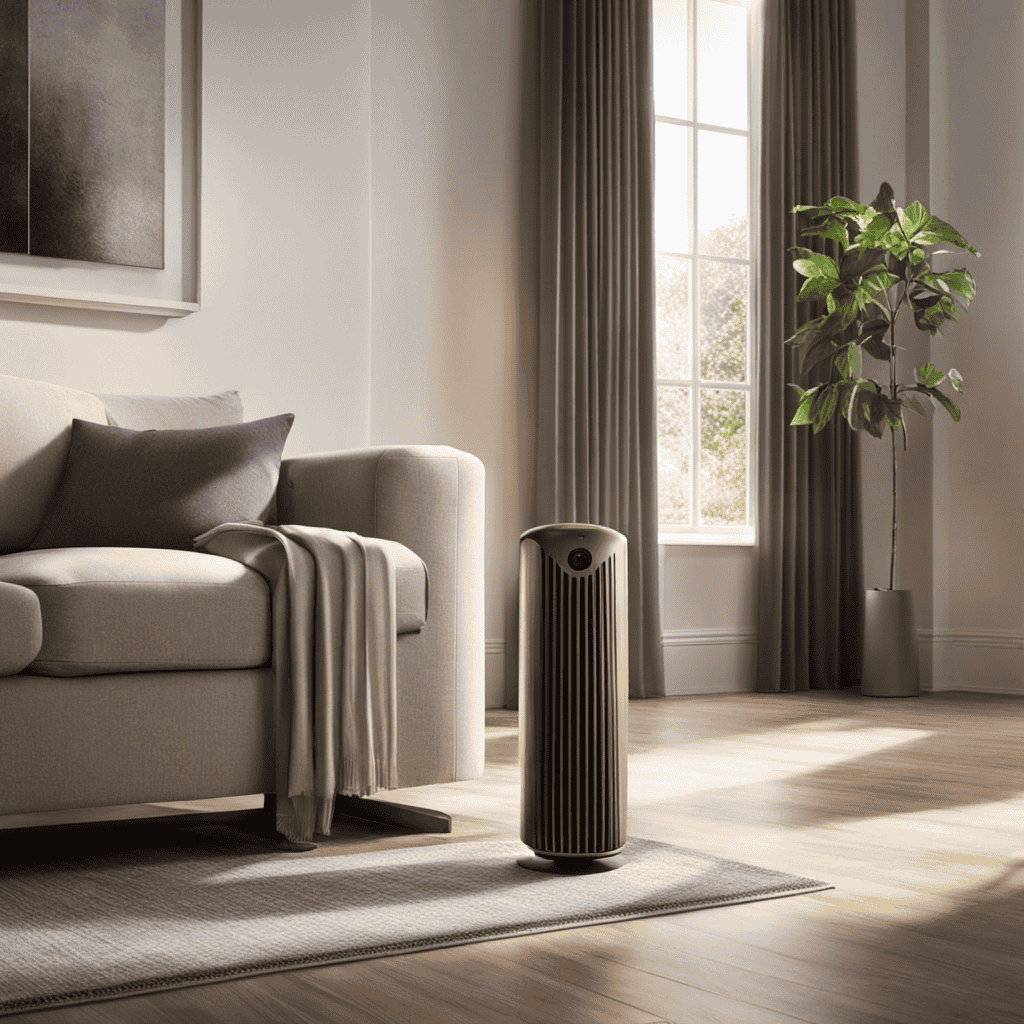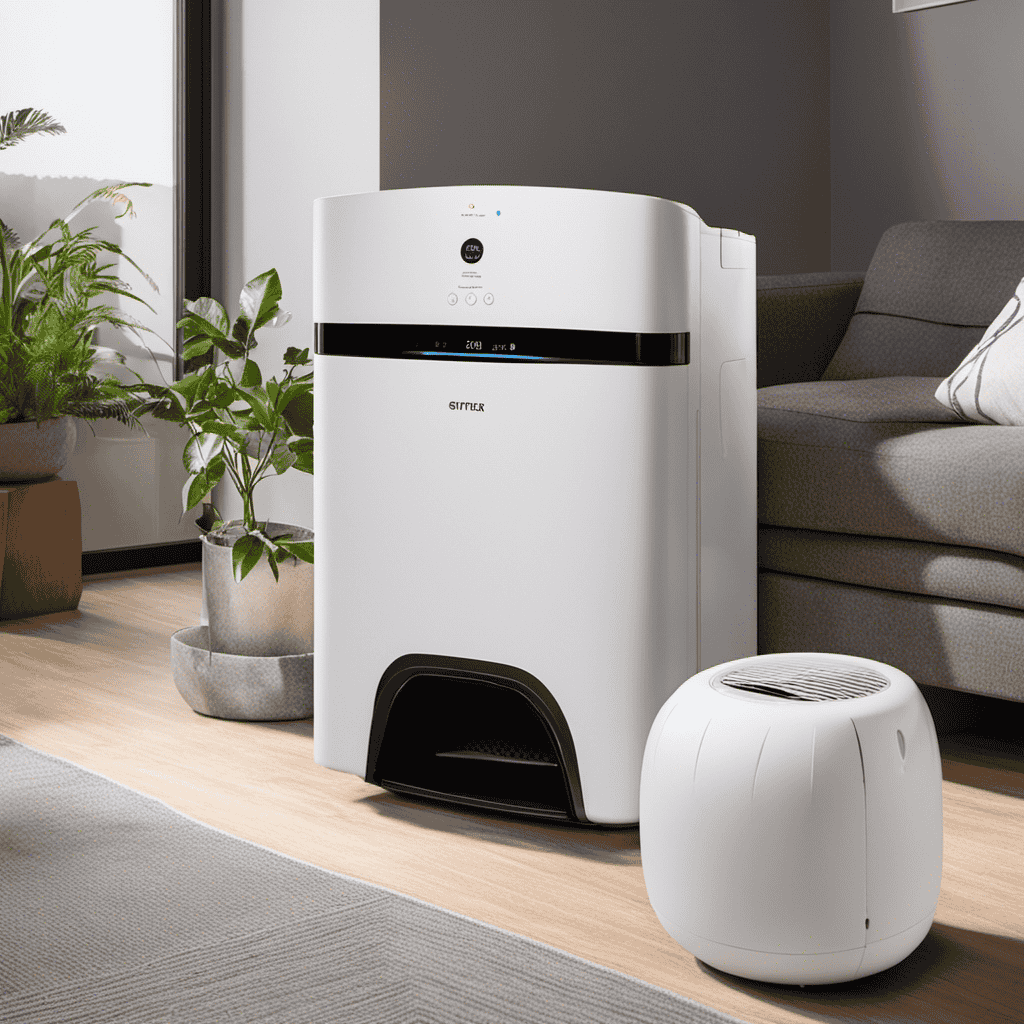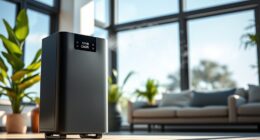As the saying goes, “Out with the old, in with the new.” This is especially true when it comes to air purifiers and carbon filters. It is essential to regularly replace your carbon filter to ensure that the air in your home remains clean and healthy.
But how often should you replace it? In this article, I will delve into the importance of regular carbon filter replacement, factors affecting its lifespan, recommended timeframes, and signs that indicate a change is needed.
Stay tuned to ensure your air purifier is working at its best.
Key Takeaways
- Regularly changing the carbon filter is crucial for maintaining the effectiveness of an air purifier in improving indoor air quality.
- Following the manufacturer’s recommendations for filter replacement frequency is important to ensure optimal performance and prolong the lifespan of the air purifier.
- Factors such as the level of air pollution, carbon quality, airflow rate, and pre-filter effectiveness determine the recommended timeframe for carbon filter replacement.
- Proper maintenance and minimizing exposure to airborne pollutants can help prolong the lifespan of carbon filters.
The Importance of Regular Carbon Filter Replacement
You should be aware of the importance of regularly changing your carbon filter in an air purifier. Maintaining a clean and functioning carbon filter is crucial for ensuring the effectiveness of your air purifier in improving indoor air quality. Carbon filters are designed to trap and remove harmful pollutants, odors, and chemicals from the air, providing you with clean and fresh air to breathe. However, over time, these filters can become clogged with debris and lose their efficiency.
By regularly changing your carbon filter, you can ensure that your air purifier continues to effectively remove airborne contaminants and maintain optimal performance.
To keep your carbon filter in top condition, here are some maintenance tips to follow. Firstly, check the manufacturer’s guidelines to determine the recommended replacement frequency for your specific air purifier model. Generally, carbon filters should be changed every 3 to 6 months, depending on usage and air quality. Secondly, regularly inspect your filter for signs of wear or damage. If you notice any tears, holes, or excessive dirt buildup, it’s time to replace the filter. Lastly, make sure to clean or replace your pre-filter regularly, as it helps to extend the lifespan of your carbon filter by capturing larger particles before they reach the carbon layer.
Understanding the Lifespan of Carbon Filters
As a researcher in the field of air purification, I’ve gathered valuable information on the lifespan of carbon filters.
In this discussion, we’ll explore three key points:
- Filter replacement frequency
- Signs of filter exhaustion
- Methods for prolonging the lifespan of filters
Filter Replacement Frequency
When it comes to the frequency of replacing your carbon filter in an air purifier, it’s important to follow the manufacturer’s recommendations. Understanding filter efficiency and the benefits of regular filter changes are crucial in maintaining clean and healthy air in your home. Carbon filters are designed to capture and remove odors, chemicals, and volatile organic compounds (VOCs) from the air. Over time, these filters become saturated and lose their effectiveness. Regularly replacing your carbon filter ensures optimal performance and helps prolong the lifespan of your air purifier. Here is a table summarizing the recommended filter replacement frequencies for various types of air purifiers:
| Air Purifier Type | Recommended Filter Replacement Frequency |
|---|---|
| Small Room | Every 3-6 months |
| Medium Room | Every 6-12 months |
| Large Room | Every 12-18 months |
| Whole House | Every 18-24 months |
Signs of Filter Exhaustion
If your home starts to smell musty or you notice a decline in air quality, it’s a sign that the filter may need replacing.
Filter maintenance is crucial for ensuring optimal filter efficiency and maintaining clean air in your home. As the filter collects airborne particles, it can become clogged over time, reducing its effectiveness. Regularly replacing the filter is necessary to ensure that it continues to capture pollutants effectively.
Dirty filters can also decrease the airflow in your air purifier, putting strain on the motor and potentially leading to its premature failure. To prevent these issues and prolong the filter’s lifespan, it is recommended to follow the manufacturer’s guidelines for filter replacement frequency.
Prolonging Filter Lifespan
Regularly replacing the filter is vital for maintaining optimal filter efficiency and clean air in your home. However, there are ways to extend the lifespan of your filter and maximize its performance. Here are some techniques to help you achieve this:
-
Proper maintenance: Regularly cleaning your filter can help remove dust and debris, allowing it to function more effectively. This can be done by gently vacuuming the filter or rinsing it with water, depending on the manufacturer’s instructions.
-
Avoiding pollutants: Minimizing exposure to airborne pollutants can reduce the strain on your filter. This includes keeping windows closed during high pollution days, using exhaust fans in the kitchen and bathroom, and ensuring proper ventilation in your home.
Factors Affecting the Replacement Frequency of Carbon Filters
One of the factors that affects the replacement frequency of carbon filters is the level of air pollution in your environment. The more polluted the air, the more contaminants the filter will have to trap, leading to a quicker saturation and reduced performance. However, pollution is not the only factor to consider. Other factors that can affect filter performance include:
| Factors Affecting Filter Performance | Impact on Filter Lifespan |
|---|---|
| Type and quality of carbon used | Higher quality carbon lasts longer and performs better. |
| Airflow rate | Higher airflow rates can decrease filter lifespan. |
| Pre-filter effectiveness | A pre-filter can extend the lifespan of the carbon filter by trapping larger particles. |
Timely replacement of carbon filters offers several benefits. Firstly, it ensures that the air purifier continues to effectively remove harmful pollutants from the air, maintaining a healthy indoor environment. Secondly, it prevents the release of trapped pollutants back into the air, which can lead to decreased air quality and potential health risks. Lastly, regular filter replacement helps to optimize the performance and energy efficiency of the air purifier, ensuring it operates at its highest capacity.
Recommended Timeframes for Carbon Filter Replacement
The recommended timeframe for replacing carbon filters depends on various factors such as the level of air pollution, carbon quality, airflow rate, and pre-filter effectiveness. It is important to maintain filter efficiency to ensure clean and healthy indoor air. Here are the recommended filter replacement intervals based on these factors:
-
Level of Air Pollution:
-
High pollution areas: Filters should be replaced every 3 to 6 months to ensure optimal performance.
-
Moderate pollution areas: Filters can be replaced every 6 to 12 months.
-
Low pollution areas: Filters can be replaced every 12 to 18 months.
-
Carbon Quality:
-
High-quality carbon filters tend to have longer lifespans and can last up to 18 months.
-
Lower quality carbon filters may require more frequent replacement, approximately every 6 to 12 months.
Maintaining the airflow rate and pre-filter effectiveness also play a crucial role in determining filter replacement intervals. Regularly cleaning and replacing the pre-filter can help extend the lifespan of the carbon filter. Additionally, monitoring the airflow rate can provide valuable insights into filter efficiency and the need for replacement.
Signs That Indicate a Carbon Filter Change Is Needed
In order to ensure the optimal performance of an air purifier, proper filter maintenance is crucial. Knowing when to replace the carbon filter is important. It is equally important to understand the signs that indicate a carbon filter change is needed. By recognizing these signs early on, you can prevent any potential negative effects on air quality and prolong the filter’s longevity.
One common sign that indicates a carbon filter change is a noticeable decrease in air purification efficiency. If your air purifier is no longer effectively removing odors or harmful gases from the air, it may be time to replace the carbon filter. Additionally, if you start experiencing increased allergy symptoms or respiratory issues, it could be a sign that the carbon filter is no longer trapping allergens or pollutants effectively.
Regularly inspecting the carbon filter for visible signs of wear and tear is also an important part of filter maintenance. If you notice that the filter is discolored, damaged, or clogged with debris, it is likely time for a replacement.
Extending the Lifespan of Carbon Filters
As an air filtration expert, I’ve conducted extensive research on ways to prolong the lifespan of carbon filters and ensure effective filter maintenance.
By implementing certain strategies, such as regular cleaning and proper usage, carbon filters can be kept in optimal condition for longer periods of time.
Additionally, understanding the factors that affect filter lifespan, such as air quality and usage frequency, can help users make informed decisions to maximize the longevity of their carbon filters.
Prolonging Carbon Filter Lifespan
To prolong the lifespan of your carbon filter in the air purifier, you should regularly clean and replace it according to the manufacturer’s instructions. Proper maintenance is crucial for prolonging filter efficiency and maximizing filter effectiveness.
Here are some important points to consider:
-
Regular cleaning: Remove the carbon filter from the air purifier and clean it with a soft brush or vacuum cleaner. This will help remove any dust or debris that may have accumulated on the surface, ensuring optimal filtration.
-
Replacement schedule: Follow the manufacturer’s recommended replacement schedule for your specific air purifier model. Carbon filters have a limited lifespan, and replacing them at the right time is essential to maintain the highest level of air purification.
Taking these steps will not only prolong the lifespan of your carbon filter but also ensure that your air purifier continues to provide clean and fresh air.
Now, let’s dive into the next section about effective filter maintenance.
Effective Filter Maintenance
Make sure you regularly clean and replace your filter according to the manufacturer’s instructions to effectively maintain it. Proper filter maintenance is crucial in prolonging filter effectiveness and ensuring the optimal performance of your air purifier.
Here are some filter maintenance tips to help you with this task.
First, it is important to vacuum or dust the filter regularly to remove any particles or debris that may have accumulated on the surface.
Additionally, some filters can be washed with water or a mild detergent to remove stubborn dirt. However, be sure to check the manufacturer’s instructions as not all filters are washable.
Finally, it is essential to replace the filter as recommended by the manufacturer, usually every 6 to 12 months, to ensure optimum filtration efficiency.
How to Properly Maintain Carbon Filters
You should regularly replace the carbon filter in your air purifier to ensure it functions properly. Carbon filters play a crucial role in removing odors, gases, and volatile organic compounds (VOCs) from the air. Over time, these filters can become clogged and less effective, leading to a decrease in air quality.
To prolong filter efficiency and avoid potential issues, there are a few key steps you can take:
-
Regularly check the manufacturer’s guidelines for recommended replacement intervals. This can vary depending on factors such as the size of the filter, the air quality in your area, and the usage of the air purifier.
-
Monitor the air purifier’s performance. If you notice a decrease in airflow or a persistent odor, it may be an indication that the carbon filter needs to be replaced.
-
Clean the pre-filter regularly to prevent debris from clogging the carbon filter. This can help maintain its effectiveness and prolong its lifespan.
-
Consider using an air quality monitor to track pollutant levels and determine when the filter needs to be replaced.
-
If you are experiencing persistent issues with your carbon filter, such as a strong odor or a decrease in performance, contact the manufacturer for troubleshooting assistance.
The Impact of Neglecting Carbon Filter Replacement
Neglecting to replace the carbon filter in an air purifier can have a significant impact on air quality and lead to serious health consequences. As a researcher in the field of indoor air quality, I have come across numerous studies that highlight the importance of regular filter replacement.
Carbon filters are designed to trap and remove harmful gases, odors, and volatile organic compounds (VOCs) from the air. Over time, these filters become saturated with the pollutants they have captured, reducing their effectiveness. If not replaced in a timely manner, the trapped pollutants can be released back into the air, compromising the overall air quality.
Poor air quality can have detrimental effects on our health. Exposure to pollutants such as VOCs has been linked to respiratory issues, allergies, and even long-term health problems like asthma and cardiovascular diseases. Additionally, prolonged exposure to indoor air pollutants can impair cognitive function and affect overall well-being.
To ensure optimal air quality and minimize health risks, it is crucial to follow the manufacturer’s recommendations for carbon filter replacement. Regularly replacing the carbon filter will help maintain a clean and healthy indoor environment, reducing the risk of respiratory issues and other health consequences associated with poor air quality.
Different Types of Air Purifiers and Their Carbon Filter Replacement Needs
There are various types of air purifiers available, each with different needs when it comes to replacing the carbon filter. Understanding filter efficiency and the benefits of activated carbon can help us make informed decisions about our air purifier maintenance. Here are some key points to consider:
-
HEPA Filters: These air purifiers use High-Efficiency Particulate Air (HEPA) filters to trap tiny particles, such as dust, pollen, and pet dander. While HEPA filters are highly effective in removing airborne allergens, they do not typically contain activated carbon. As a result, carbon filter replacement is not necessary for HEPA purifiers.
-
Activated Carbon Filters: Air purifiers with activated carbon filters excel at removing odors, smoke, and volatile organic compounds (VOCs). The activated carbon absorbs these pollutants, trapping them within the filter. Over time, the carbon becomes saturated and loses its effectiveness. Therefore, regular replacement of the carbon filter is essential for optimal performance.
Understanding the specific needs of your air purifier is crucial in determining the optimal carbon filter replacement schedule. By considering factors such as the type of filter and the level of air pollution in your environment, you can ensure that your air purifier continues to provide clean and fresh air for you and your loved ones.
Now, let’s explore how to determine the optimal carbon filter replacement schedule.
How to Determine the Optimal Carbon Filter Replacement Schedule
To determine the optimal schedule for replacing your carbon filter, it is important to consider factors such as the type of filter and the level of air pollution in your environment. Carbon filters are designed to remove airborne contaminants, odors, and gases from the air. Over time, these filters can become saturated with pollutants and lose their effectiveness. Regular maintenance and filter replacement are essential to ensure that your air purifier continues to provide clean and fresh air.
To help you determine when to replace your carbon filter, here are some tips and guidelines:
| Type of Filter | Recommended Replacement Schedule |
|---|---|
| Standard Carbon | Every 3-6 months |
| High-Efficiency | Every 6-12 months |
| Activated Carbon | Every 6-12 months |
| Impregnated Carbon | Every 12-18 months |
Keep in mind that these are general recommendations and may vary depending on the specific air purifier model and usage. Factors such as the level of air pollution in your area and the number of people and pets in your household can also affect the lifespan of your carbon filter.
To prolong the efficacy of your carbon filter, follow these maintenance tips:
- Regularly clean the pre-filter to remove larger particles and debris.
- Vacuum the exterior of the air purifier to remove dust and dirt.
- Use the air purifier on the appropriate fan speed for your environment.
- Replace the carbon filter when it shows signs of discoloration or when the air purifier’s performance decreases.
Is It Necessary to Change Both Carbon and Hepa Filters in an Air Purifier?
When it comes to hepa filter air purifier maintenance, it is important to understand the purpose of both carbon and HEPA filters. While carbon filters target odors and gases, HEPA filters capture small particles. Changing both filters regularly ensures optimal air purification and prolongs the life of the air purifier.
Frequently Asked Questions About Carbon Filter Replacement
When it comes to maintaining the performance of an air purifier, understanding the optimal filter replacement frequency is crucial. Determining how often to change the filter depends on various factors such as the air quality, usage patterns, and the type of filter being used.
Additionally, it is important to be aware of the signs of filter deterioration. These signs include reduced airflow, unpleasant odors, or visible dirt and debris. These indicators suggest that it is time for a replacement.
Optimal Filter Replacement Frequency
You should check the manufacturer’s guidelines to determine how often you should change the carbon filter in your air purifier. The optimal filter replacement frequency varies depending on factors such as the air quality in your area, the size of the filter, and the usage of the air purifier.
However, there are some general guidelines to help you prolong the effectiveness of your carbon filter and maximize its lifespan:
-
Keep track of the filter’s color: As the carbon filter becomes saturated with pollutants, it will change color. Regularly inspect the filter and replace it when it appears discolored or dirty.
-
Monitor the air quality: If you live in an area with poor air quality or have pets or smokers in your home, you may need to change the filter more frequently to maintain optimal performance.
Signs of Filter Deterioration
In order to prolong the efficiency of your carbon filter in an air purifier, it is crucial to be aware of the signs of filter clogging.
As a user, it is important to keep an eye out for certain indicators that suggest your filter may be deteriorating. One of the first signs is a decrease in air flow. If you notice that the air purifier is not circulating as much air as before, it may be a sign that the filter is becoming clogged.
Another key indicator is a decrease in the air purifier’s ability to remove odors or eliminate pollutants effectively. If you start noticing unpleasant smells or if your allergies worsen, it could be a sign that the filter is no longer functioning optimally.
Frequently Asked Questions
Can I Clean and Reuse a Carbon Filter Instead of Replacing It?
Sure, I can clean and reuse a carbon filter instead of replacing it. However, it’s important to note that the effectiveness of cleaning methods may vary.
While some carbon filters can be rinsed or vacuumed to remove dust and debris, others may require more thorough cleaning techniques. It’s recommended to refer to the manufacturer’s instructions for specific cleaning guidelines.
Regularly inspecting the filter and replacing it when necessary is crucial to maintain optimal air purification performance.
Are There Any Health Risks Associated With Using a Carbon Filter That Needs to Be Replaced?
There are potential health risks associated with using a carbon filter that needs to be replaced. When a carbon filter becomes clogged or saturated, it loses its ability to effectively remove pollutants from the air. This can lead to poor indoor air quality, which can trigger respiratory issues and allergies.
It is therefore important to regularly check and replace carbon filters in air purifiers to ensure optimal performance and maintain a healthy living environment.
How Do I Know if I Have a Carbon Filter That Needs to Be Replaced?
To determine if a carbon filter needs to be replaced, there are a few signs to look out for. Firstly, if you notice a decline in the air quality or a return of odors, it may be time for a replacement.
Additionally, a visual inspection of the filter can reveal signs of wear and tear, such as discoloration or clogging.
To extend the lifespan of a carbon filter, regular cleaning and proper maintenance are essential.
Can I Use a Carbon Filter for a Longer Period of Time if I Use My Air Purifier Less Frequently?
When it comes to maintaining my air purifier’s carbon filter, I often wonder if using it less frequently could extend its lifespan. While it may seem logical, it’s important to remember that carbon filters have a recommended lifespan.
To ensure optimal performance and air quality, it’s best to follow the manufacturer’s guidelines for filter replacement. Regularly changing the carbon filter, regardless of usage frequency, is one of the best practices for maintaining an effective air purification system.
Are There Any Specific Brands or Types of Carbon Filters That Are More Durable and Longer-Lasting Than Others?
There are various types of carbon filters available in the market, each with their own pros and cons. Some brands offer carbon filters that are more durable and longer-lasting than others.
It’s important to do research and compare the longevity and effectiveness of carbon filters from different brands before making a purchase. This will ensure that you find a carbon filter that suits your needs and lasts for a longer period of time.
Conclusion
In conclusion, regular carbon filter replacement is crucial for maintaining the effectiveness of an air purifier. By understanding the lifespan of carbon filters and considering factors such as air quality and usage, one can determine the optimal replacement schedule.
Neglecting to replace carbon filters can result in decreased air purification performance and potential health risks. For instance, a case study conducted in a heavily polluted area showed that neglecting carbon filter replacement led to increased respiratory issues among residents.
Therefore, it is important to follow recommended timeframes and signs indicating the need for a filter change.
